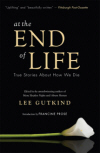At the End of Life
The twenty-two essays in this collection were chosen from four hundred submissions in response to Lee Gutkind’s (editor of Creative Nonfiction literary magazine) call for essays on the subject of death. The book is a collaboration of Creative Nonfiction and the Jewish Healthcare Foundation. While it isn’t a book one would choose for entertainment or casual reading, it is an important one that offers an expansive view, from various perspectives, on how we deal with death and dying.
The twenty-two essays in this collection were chosen from four hundred submissions in response to Lee Gutkind’s (editor of Creative Nonfiction literary magazine) call for essays on the subject of death. The book is a collaboration of Creative Nonfiction and the Jewish Healthcare Foundation. While it isn’t a book one would choose for entertainment or casual reading, it is an important one that offers an expansive view, from various perspectives, on how we deal with death and dying.
Though death is the central topic of each of these essays, the narrators’ living voices transmit messages of courage, hope, and healing. In his editor’s note, Gutkind reveals that he initially agreed with his editor’s response that the collection was “completely depressing.” However, he explains that he now believes “the messages inherent in these essays are positive, demonstrating that people can die with strength and dignity and, even more to the point, that their loved ones can endure these deaths and go forward in their lives, with strength and dignity and even a sense of confidence and hope.” Francine Prose writes in the introduction that “Many of these narratives feel like messages in bottles, washed up on the shore—urgent communications whose authors hope they will reach the land of the healthy and the living.”
Each of these essays, whether written by an established, published writer or by a writer published for the first time, portrays a personal perspective on the topic of death. Among the contributors are mothers, daughters, sons, grandsons, physicians, hospice workers, a nurse, a 911 dispatcher, a lawyer, and a physical therapist. Two of the most heartbreaking stories are by mothers writing about the deaths of their daughters: one at age twelve, after a four-year battle with leukemia, and the other at age nineteen, hours after suffering a traumatic brain injury.
The essays contain some startling statistics about current healthcare and funeral practices. For instance, Valerie Seiling Jacobs reveals in her essay “A Better Place” that: “71 percent of men admitted to nursing homes don’t last three months . . . 80 percent don’t last six months,” and Joe Primo estimates in “The Business of Grief” that we “use enough metal in caskets and underground vaults that we could rebuild the Golden Gate Bridge every January.” Eleanor Vincent’s essay “The Resurrection of Wonder Woman,” about her decision to donate her teenaged daughter’s organs, reveals that “more than 105,000 people await transplants in the United States today. Each day, on average, eighteen of them die waiting.” Although some of these statistics are frightening, the overall tone of the book is positive. I’m particularly encouraged by the compassion and conscience displayed by the healthcare workers. For example, a nurse participating in a clinical rotation in a hospital’s pediatric ward fakes the paperwork she submits to her boss to instead spend time playing with Matchbox cars with a dying patient. In another essay, a mother stands at her daughter’s bedside, courageously giving her permission to die, and when two doctors approach the room to perform lifesaving measures, the girl’s favorite nurse bodily blocks the door.
As expected given the subject matter, this collection contains an ample amount of sadness. But these writers deftly use details, metaphor, and lyricism to create art instead of sentimentality. In “Yellow Taxi,” hospice worker Eve Joseph describes a comatose patient, writing: “I remember looking at her pale skin and black hair and thinking she looked like Snow White in a Red Cross bed.” In another passage from this same essay, Joseph notes that “those who work with the dying must learn to think like the poet who reaches for language the way a child reaches for the moon, believing it can be held in the hand like an orange at the same time it shines on in the night sky.”
Although the subjects of these essays vary in age, background, ethnicity, and social status, they share several recurring themes. For example, the prevailing belief is that the dying need their loved ones to give them permission to die. Other recurring themes involve rituals, such as leaving the window slightly open to allow the spirit to escape and the ceremonial bathing of the body.
Many passages of this book are painfully difficult to read; however, the essays are also beautifully written tributes to the lives they portray. In “The Measure of Time,” Amanda J. Redig concludes that “what matters is not how we die but rather why we choose to live.” I agree with Francine Prose when she says that “we can only feel grateful for having experienced the intensity and the sheer amount of life that has been compressed and contained in a book about its end.”





